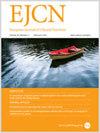女性减肥手术后中长期静息能量消耗:间接量热法和预测方法之间的一致性。
IF 3.3
3区 医学
Q2 NUTRITION & DIETETICS
引用次数: 0
摘要
背景/目的:预测方程估计减肥手术后静息能量消耗(REE),但缺乏准确性评估,特别是对剩余体重。本研究旨在评价间接量热法与稀土元素预测方法之间的一致性。受试者/方法:226名女性入组[中位年龄43.0岁;50.4)岁]接受roux -en- y术后中长期胃旁路术的患者[术后中位时间6.1 (4.0;9.0年)。测量REE (mREE)采用间接量热法,估算REE (eREE)采用18个预测方程和人工神经网络模型。对总样本和身体质量指数(BMI)亚组进行了分析(结果:BMI结论:估算REE的方程显示出广泛的表现差异,在该人群中,特别是在BMI为30 kg/m²的人群中,准确的选择有限。本文章由计算机程序翻译,如有差异,请以英文原文为准。

Resting energy expenditure of females mid- to long-term after bariatric surgery: agreement between indirect calorimetry and predictive methods
Predictive equations estimate post-bariatric surgery resting energy expenditure (REE), but lack accuracy assessment, especially for the remaining body mass. This study aimed to evaluate the agreement between indirect calorimetry and REE predictive methods. It enrolled 226 females [median age 43.0 (36.2; 50.4) years] who underwent mid- to long-term post-Roux-en-Y gastric bypass [median postoperative time 6.1 (4.0; 9.0) years]. The measured REE (mREE) was obtained using indirect calorimetry, while the estimated REE (eREE) was derived from 18 predictive equations and an artificial neural network model. Analyses were performed for the total sample and body mass index (BMI) subgroups (<30 kg/m² and ≥30 kg/m²). eREE within ±10% of mREE was considered accurate; Bland–Altman plots were performed to evaluate agreement. In the BMI < 30 kg/m² subgroup [n = 115; 1372 ± 153 kcal (5744.3 ± 640.6 kJ)], mREE did not differ from four predictive equations; Henry [1371 ± 95 kcal (5740.1 ± 397.8 kJ), p = 0.922, bias −1.0 kcal (−4.2 kJ)] and Dietary Reference Intakes-Institute of Medicine [1382 ± 102 kcal (5786.2 ± 427.1 kJ), p = 0.315, bias 10.2 kcal (42.7 kJ)] equations showed better agreement and accurate prediction performance among BMI categories (79.1 and 82.6%, respectively). The BMI ≥ 30 kg/m² subgroup mREE [n = 111; 1516 ± 186 kcal (6347.2 ± 778.7 kJ)] was significantly lower than all predictive methods and had higher bias and over-prediction, except for Mifflin-St Jeor equation [1523 ± 186 kcal (6376.5 ± 778.7 kJ), p = 0.469, bias 7.7 kcal (32.2 kJ)]. Equations for estimating REE show wide performance variation, with limited accurate options in this population, especially among those with BMI > 30 kg/m².
求助全文
通过发布文献求助,成功后即可免费获取论文全文。
去求助
来源期刊
CiteScore
10.60
自引率
2.10%
发文量
189
审稿时长
3-6 weeks
期刊介绍:
The European Journal of Clinical Nutrition (EJCN) is an international, peer-reviewed journal covering all aspects of human and clinical nutrition. The journal welcomes original research, reviews, case reports and brief communications based on clinical, metabolic and epidemiological studies that describe methodologies, mechanisms, associations and benefits of nutritional interventions for clinical disease and health promotion.
Topics of interest include but are not limited to:
Nutrition and Health (including climate and ecological aspects)
Metabolism & Metabolomics
Genomics and personalized strategies in nutrition
Nutrition during the early life cycle
Health issues and nutrition in the elderly
Phenotyping in clinical nutrition
Nutrition in acute and chronic diseases
The double burden of ''malnutrition'': Under-nutrition and Obesity
Prevention of Non Communicable Diseases (NCD)

 求助内容:
求助内容: 应助结果提醒方式:
应助结果提醒方式:


